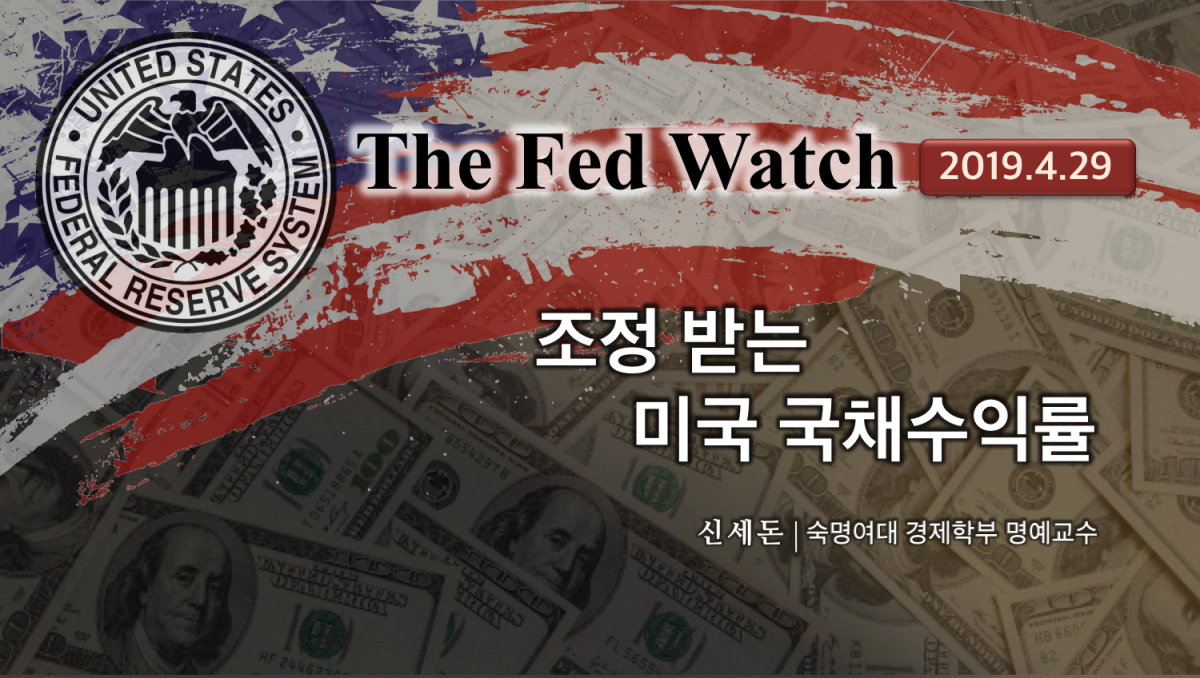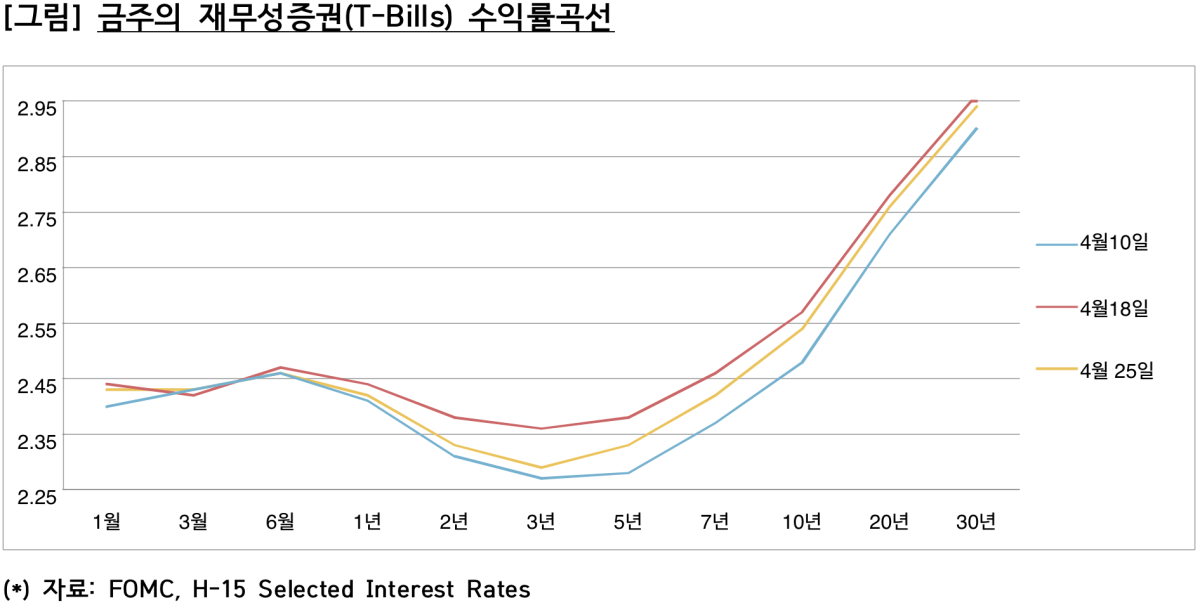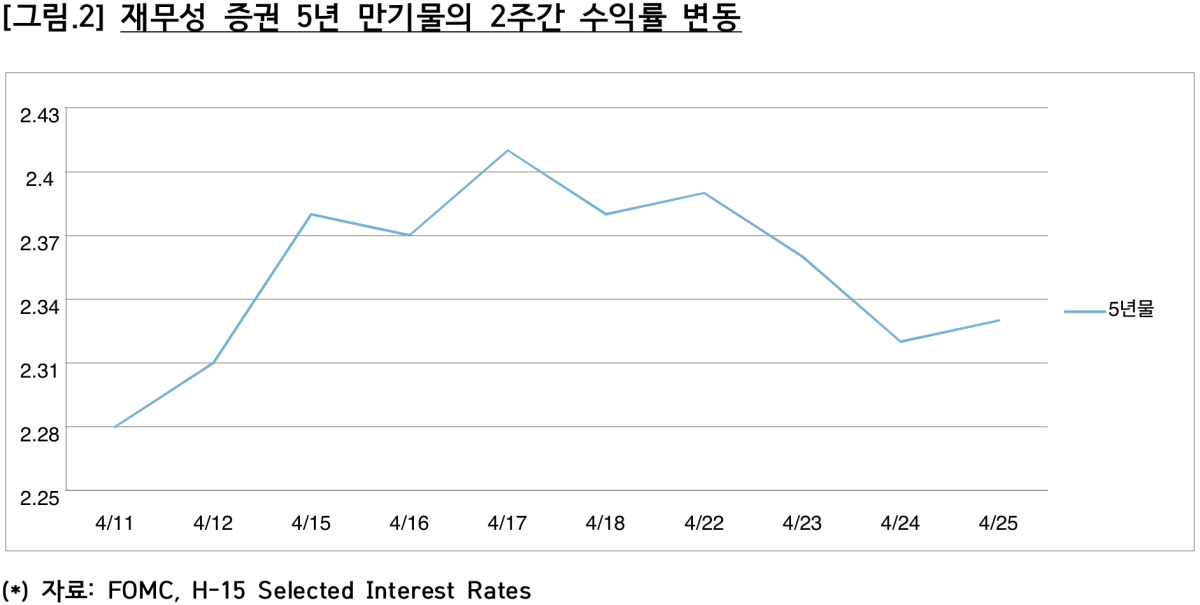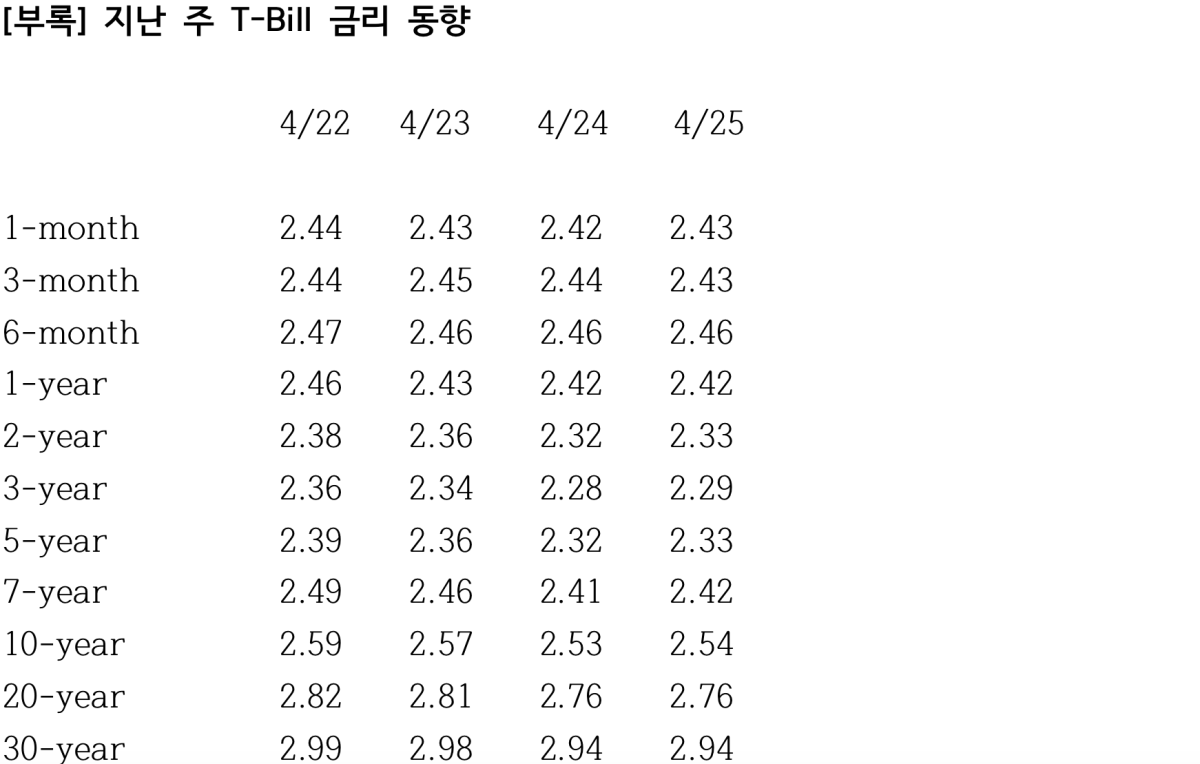관련링크
본문
<1> 금주의 T-Bill 수익률 곡선(Yield Curve)
4월 22일-25일 주간 미국 재무성 증권 수익률은 3개월 만기 물을 제외한 모든
만기 물에서 1bp-7bp 하락.
특히 2년 물(5bp), 3년 물(7bp), 및 5년 물(5bp) 하락폭이 컸음.
이는 4월 15-18일 주간 수익률이 크게 상승(6bp-10bp)했던 것에 대한 조정 성격.
5년 물의 경우 4/17일 2.41%에서 4/25일 2.33%으로 8bp 하락했음.
다음 주 수익률의 향배가 중장기 국채수익률의 흐름에 중요한 고비가 될 것임.
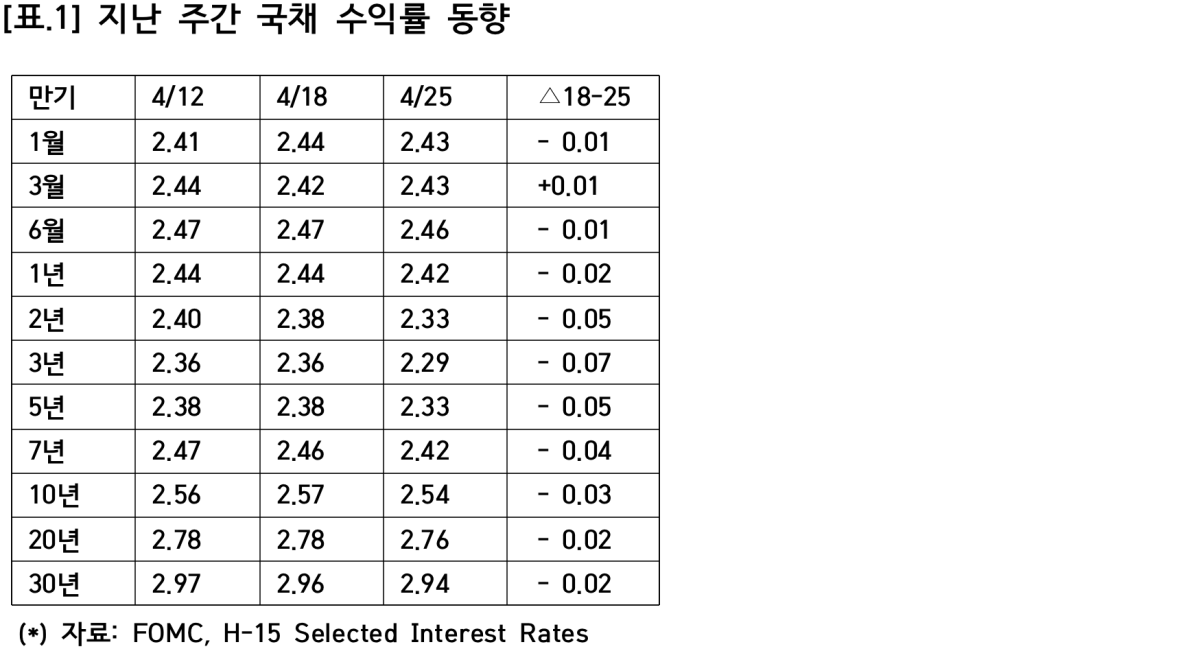
<2> 파월 의장이 국회 제출한 연준 반기통화정책보고서(2019년 2월 27일)
[(*참고) 연방준비제도법에 따르면 연준이사회는 일 년에 두 번(2월과 7월) 의회에 「통화정책보고서」를 제출하도록 규정되어있다. 통화보고서에는 ②통화정책은 물론 ①경제의 현재상황과 미래에 대한 전망을 담도록 되어있다. 이 보고서는 상원의 ‘은행, 주택 및 도시문제위원회’와 하원의 ’금융위원회’에 제출하도록 되어 있으며 반드시 연준 의장의 출석발표가 의무화 되어있다.]
Good morning. Chairman Crapo, Ranking Member Brown, and other members of the Committee, I am happy to present the Federal Reserve's semiannual Monetary Policy Report to the Congress.
Let me start by saying that my colleagues and I strongly support the goals Congress has set for monetary policy--maximum employment and price stability. We are committed to providing transparency about the Federal Reserve's policies and programs. Congress has entrusted us with an important degree of independence so that we can pursue our mandate without concern for short-term political considerations. We appreciate that our independence brings with it the need to provide transparency so that Americans and their representatives in Congress understand our policy actions and can hold us accountable. We are always grateful for opportunities, such as today's hearing, to demonstrate the Fed's deep commitment to transparency and accountability.
Today I will review the current economic situation and outlook before turning to monetary policy. I will also describe several recent improvements to our communications practices to enhance our transparency.
① Current Economic Situation and Outlook
The economy grew at a strong pace, on balance, last year, and employment and inflation remain close to the Federal Reserve's statutory goals of maximum employment and stable prices‑‑our dual mandate.
Based on the available data, we estimate that gross domestic product (GDP) rose a little less than 3 percent last year following a 2.5 percent increase in 2017. Last year's growth was led by strong gains in consumer spending and increases in business investment. Growth was supported by increases in employment and wages, optimism among households and businesses, and fiscal policy actions. In the last couple of months, some data have softened but still point to spending gains this quarter. While the partial government shutdown created significant hardship for government workers and many others, the negative effects on the economy are expected to be fairly modest and to largely unwind over the next several months.
The job market remains strong. Monthly job gains averaged 223,000 in 2018, and payrolls increased an additional 304,000 in January. The unemployment rate stood at 4 percent in January, a very low level by historical standards, and job openings remain abundant. Moreover, the ample availability of job opportunities appears to have encouraged some people to join the workforce and some who otherwise might have left to remain in it. As a result, the labor force participation rate for people in their prime working years‑‑the share of people ages 25 to 54 who are either working or looking for work‑‑has continued to increase over the past year. In another welcome development, we are seeing signs of stronger wage growth.
The job market gains in recent years have benefited a wide range of families and individuals. Indeed, recent wage gains have been strongest for lower-skilled workers. That said, disparities persist across various groups of workers and different parts of the country. For example, unemployment rates for African Americans and Hispanics are still well above the jobless rates for whites and Asians. Likewise, the percentage of the population with a job is noticeably lower in rural communities than in urban areas, and that gap has widened over the past decade. The February Monetary Policy Report provides additional information on employment disparities between rural and urban areas.
Overall consumer price inflation, as measured by the 12-month change in the price index for personal consumption expenditures (PCE), is estimated to have been 1.7 percent in December, held down by recent declines in energy prices. Core PCE inflation, which excludes food and energy prices and tends to be a better indicator of future inflation, is estimated at 1.9 percent. At our January meeting, my colleagues and I generally expected economic activity to expand at a solid pace, albeit somewhat slower than in 2018, and the job market to remain strong. Recent declines in energy prices will likely push headline inflation further below the Federal Open Market Committee's (FOMC) longer-run goal of 2 percent for a time, but aside from those transitory effects, we expect that inflation will run close to 2 percent.
While we view current economic conditions as healthy and the economic outlook as favorable, over the past few months we have seen some crosscurrents and conflicting signals. Financial markets became more volatile toward year-end, and financial conditions are now less supportive of growth than they were earlier last year. Growth has slowed in some major foreign economies, particularly China and Europe. And uncertainty is elevated around several unresolved government policy issues, including Brexit and ongoing trade negotiations. We will carefully monitor these issues as they evolve.
In addition, our nation faces important longer-run challenges. For example, productivity growth, which is what drives rising real wages and living standards over the longer term, has been too low. Likewise, in contrast to 25 years ago, labor force participation among prime-age men and women is now lower in the United States than in most other advanced economies. Other longer-run trends, such as relatively stagnant incomes for many families and a lack of upward economic mobility among people with lower incomes, also remain important challenges. And it is widely agreed that federal government debt is on an unsustainable path. As a nation, addressing these pressing issues could contribute greatly to the longer-run health and vitality of the U.S. economy.
②Monetary Policy
Over the second half of 2018, as the labor market kept strengthening and economic activity continued to expand strongly, the FOMC gradually moved interest rates toward levels that are more normal for a healthy economy. Specifically, at our September and December meetings we decided to raise the target range for the federal funds rate by 1/4 percentage point at each, putting the current range at 2-1/4 to 2-1/2 percent.
At our December meeting, we stressed that the extent and timing of any further rate increases would depend on incoming data and the evolving outlook. We also noted that we would be paying close attention to global economic and financial developments and assessing their implications for the outlook. In January, with inflation pressures muted, the FOMC determined that the cumulative effects of these developments, along with ongoing government policy uncertainty, warranted taking a patient approach with regard to future policy changes. Going forward, our policy decisions will continue to be data dependent and will take into account new information as economic conditions and the outlook evolve.
For guideposts on appropriate policy, the FOMC routinely looks at monetary policy rules that recommend a level for the federal funds rate based on measures of inflation and the cyclical position of the U.S. economy. The February Monetary Policy Report gives an update on monetary policy rules. I continue to find these rules to be helpful benchmarks, but, of course, no simple rule can adequately capture the full range of factors the Committee must assess in conducting policy. We do, however, conduct monetary policy in a systematic manner to promote our long-run goals of maximum employment and stable prices. As part of this approach, we strive to communicate clearly about our monetary policy decisions.
We have also continued to gradually shrink the size of our balance sheet by reducing our holdings of Treasury and agency securities. The Federal Reserve's total assets declined about $310 billion since the middle of last year and currently stand at close to $4.0 trillion. Relative to their peak level in 2014, banks' reserve balances with the Federal Reserve have declined by around $1.2 trillion, a drop of more than 40 percent.
In light of the substantial progress we have made in reducing reserves, and after extensive deliberations, the Committee decided at our January meeting to continue over the longer run to implement policy with our current operating procedure. That is, we will continue to use our administered rates to control the policy rate, with an ample supply of reserves so that active management of reserves is not required. Having made this decision, the Committee can now evaluate the appropriate timing and approach for the end of balance sheet runoff. I would note that we are prepared to adjust any of the details for completing balance sheet normalization in light of economic and financial developments. In the longer run, the size of the balance sheet will be determined by the demand for Federal Reserve liabilities such as currency and bank reserves. The February Monetary Policy Report describes these liabilities and reviews the factors that influence their size over the longer run.
I will conclude by mentioning some further progress we have made in improving transparency. Late last year we launched two new publications: The first, Financial Stability Report, shares our assessment of the resilience of the U.S. financial system, and the second, Supervision and Regulation Report, provides information about our activities as a bank supervisor and regulator. Last month we began conducting press conferences after every FOMC meeting instead of every other one. The change will allow me to more fully and more frequently explain the Committee's thinking. Last November we announced a plan to conduct a comprehensive review of the strategies, tools, and communications practices we use to pursue our congressionally assigned goals for monetary policy. This review will include outreach to a broad range of stakeholders across the country. The February Monetary Policy Report provides further discussion of these initiatives.
Thank you. I am happy to respond to questions.
<3> 연준 이사 랜덜 퀄즈 (Randal Quarles, 1957년 9월 5일 - )
랜덜 퀄즈 연준 이사는 2017년 7월 트럼프 대통령의 추천을 받고 10월 상원에서 찬성 65 반대 32의 인준을 받아 14년 임기의 연준 이사 및 4년 임기의 은행감독 담당 연준 부의장이 되었다. 그의 이사 임기는 따라서 2032년 1월 말에 끝나고 부의장 임기는 2021년에 종료된다. 은행감독 담당 부의장 자리는 2008년 금융위직 이후 제정된 2010년 도드-프랭크 법에 의해 설치되었으나 그동안 공석으로 있었는데 퀄즈가 최초로 임명된 것이다.
샌프란시스코에서 1957년 9월 5일 태어났으나 1975년 유타에서 고등학교를 졸업하고 컬럼비아 대학(1981년 졸업)과 예일 법대를 졸업(1984년)했다. 예일 법대에서 금융기관관련 법을 공부하고 졸업한 직후 퀄즈는 뉴욕 월가 법률회사 Davis Polk & Wardwell에 입사하여 주로 금융기관의 합병에 관한 업무에 종사하였으며 그의 능력을 인정받아서 법률회사의 금융기관파트의 최고 책임자가 되었다.
1990년 부시 정부의 브래디 재무장관이 퀄즈를 영입하여 1993녀 까지 특별보좌관으로 일하기도 했다. 1993년 다시 원래 일하던 법률회사 DPW로 돌아간 퀄즈는 2001년 당시 재무부장관 오닐의 요청을 받고 다시 재무부로 들어가 2002년 4월까지 주로 IMF와 관련된 일을 하다가 2002년 4월부터 2005년 8월까지 국제금융문제 담당 차관보로 있었다. 그동안 그는 중국위안화 절하문제, 아르헨티나 부채문제, 아프간 및 이라크 경제재건문제 등 주로 국제 문제를 담당했으며 그와 함께 외국자본의 미국 내 투자문제에 관한 업무도 미국의 안보유지 차원에서 다루었다. 그는 국제금융의 안정을 위해서는 국가 간의 규제협력이 매우 중요하다는 점을 강조해 왔으며 특히 EU 와의 정기적인 대화가 필수적이라는 점을 강조해왔다. 이런 입장 때문에 그는2018년 11월부터 국제금융안정위원회(Financial Stabilization Board)의 의장직을 맡고 있다.
국내금융 담당 재무부차관으로써 그는 국내 금융 산업 및 금융시장 안정에 대해 중요한 역할을 수행했으며 특히 파생상품에 관한 규제와 페니 메와 프래디 맥과 같은 공적 주택금융기관의 개혁과 금융규제체제의 개혁에 많은 관심을 가져왔다. 특히 퀄즈는 금융시장의 안정 유지 차원에서 페니 메와 프래디 맥의 활동에 대한 강력한 규제가 필수적이라는 점을 강조해 왔고 투자은행과 보험회사에 대한 근본적이고 일관되며 광범위한 정부의 규제체제가 마련되어야만 한다고 주장해왔다. 2006년 퀄즈가 재무부를 떠나게 되자 재무부장관 폴슨은 그의 광범위한 기여와 공로를 기려 재무부 최상급의 영예인 알렉산더 해밀튼 상을 수여했다. 재무부를 나온 퀄즈는 사모펀드 칼라일그룹의 금융부문 사업 책임자로 영입되었다. 그 뒤 칼라일 그룹을 나온 퀄즈는 칼라일 그룹의 협력자였던 메리너 에클레즈의 도움을 받아 사이노슈어 그룹(The Cynosure Group)이라는 세계 굴지의 사모펀드기업을 세워 에클레즈의 자금을 관리하기 시작했다. 현재 연준 본부의 건물은 메리너 에클레즈의 이름을 따서 에클레즈 빌딩이라고 불리운다. 퀄즈는 메리너 에클레즈의 동생의 손녀 딸과 결혼했다. 유타에서 소년기를 보낸 몰몬교도인 퀄즈는 몰몬교 대표적인 부호 가문인 에클레즈가와의 인연을 맺어 확실한 정치적 사회적 기반을 굳히는데 성공했으며 이런 배경을 바탕으로 차기 공화당 정부에서 가장 유력한 재무부장관으로 여겨지고 있다. <ifs POST>
- 기사입력 2019년04월28일 17시05분
- 최종수정 2019년04월27일 14시11분
댓글목록
등록된 댓글이 없습니다.
